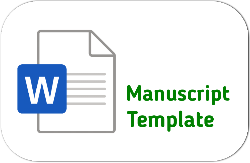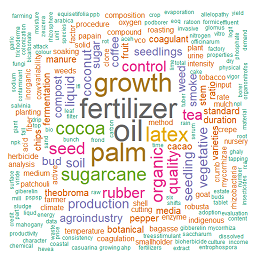Adaptasi Setek Batang Tanaman Lada (Piper nigrum L.) Menggunakan Komposisi Media Gambut dan Pupuk Organik Kotoran Kambing yang Berbeda
DOI:
https://doi.org/10.25181/jaip.v10i2.2593Keywords:
manure, percentage of live, soil acidity, stem cutting, sub-optimal wetlandsAbstract
Peatlands have good prospects for use as agricultural land. Peatlands have many problems, one of which is high acidity. Organic goat manure is expected to be able to overcome the problem of peatlands. Therefore, this study aimed to determine the best combination of peat media and organic goat manure on the pH of the media and the growth of pepper plant stem cuttings. This research was carried out for three months (October to December 2021), including taking peat soil in Sukamaju Village, Landasan Ulin Timur District, Banjarbaru, South Kalimantan; taking pepper cuttings in Senakin Village, Kotabaru Regency, South Kalimantan; planting pepper cuttings in the Greenhouse Department of Agroecotechnology Faculty Agriculture at Lambung Mangkurat University, Banjarbaru, South Kalimantan; and observing the pH of cutting media at the Production Laboratory of the Agroecotechnology Department, Faculty of Agriculture, Lambung Mangkurat University, Banjarbaru, South Kalimantan. This research used a completely randomized design (CRD) with one factor. The factor studied was the composition of the planting medium (K), which consisted of five treatments: k1 = 100% peat + 0% organic goat manure, k2 = 75% peat + 25% organic goat manure, k3 = 50% peat + 50% organic goat manure, k4 = 25% peat + 75% goat manure organic fertilizer, and k5 = 0% peat + 100% goat manure organic fertilizer. The results showed that the treatment with the composition of 0% peat + 100% organic goat manure (k5) is the best for increasing the pH of the media (6.50). The composition of 50% peat + 50% organic goat manure (k3) was the best in increasing shoot height and number of leaves (4.44 cm shoot height and 1.08 leaves), but not different from the composition of 25% peat + 75% organic fertilizer goat manure (k4) on the percentage of live cuttings, number of shoots, and leaf width (70% live cuttings, 0.70 shoots, and 2.69 cm leaf width).Downloads
References
Armansyah. (2001). Uji Efektivitas Dosis dari Beberapa Jenis Cendawan Mikoriza Arbuskular Terhadap Pertumbuhan Tanaman Gambir (Uncaria gambir. Roxb) [Unpublished master’s thesis]. Universitas Andalas.
Benbya, A. M., Alaoui, M., Gaboun, F., Delporte, F., Chlyah, O., & Cherkaoui, S. (2018). Vegetative propagation of Argania spinosa (L.) skeels cuttings: Effects of auxins and genotype. International Journal of Environment, Agriculture and Biotechnology, 3(4), 1369–1381. https://doi.org/10.13128/ahsc-8131
Caruana, R. J. C., & Cagasan, U. A. (2020). Effect of timing of goat manure and inorganic fertilizer application on productivity and profitability of sweetpotato (Ipomoea batatas (L.) Lam.). Eurasian Journal of Agricultural Research, 4(1). 1-10.
Direktorat Jenderal Perkebunan. (2015). Statistik Perkebunan Indonesia Komoditas Lada 2013-2015. Jakarta.
Fahmi, A., Syamsudin, Utami, S. N. H. & Radjagukguk, B. (2010). Pengaruh interaksi hara nitrogen dan fosfor terhadap pertumbuhan tanaman jagung (Zea mays L.) pada tanah regosol dan latosol. Berita Biologi, 10(3), 297-304.
Fathini, D. N., Sriyanto, W., & Suci, H. (2014). Pengaruh masa inkubasi vinasse dan takaran pupuk kalium terhadap pertumbuhan dan hasil cabai merah (Capsicum Annum L.). Vegetalika, 3(2), 13–24.
Fitriana, P. R., Setyobudi, L., & Santoso, M. (2016). Pengaruh pemberian kombinasi biokultur kotoran sapi dan pupuk anorganik pada pertumbuhan dan hasil baby kailan (Brassica oleracea var. Alboglabra). Jurnal Produksi Tanaman, 4(5), 325–331.
Febriani, F., Linda, R., & Lovoadi, I. (2015). Pengaruh komposisi media tanam terhadap pertumbuhan stek batang kantong semar (Nepenthes gracilis Korth.). Jurnal Protobiont, 4(2), 63-68.
Heiriyani, T., Saputra, R. A., & Helwenda. (2022). Pemanfaatan pupuk kandang untuk budidaya sawi (Brassica juncea L.) di tanah tukungan. EnviroScienteae, 18(1), 183-193. http://dx.doi.org/10.20527/es.v18i1.13008
Ifantri, J., & Ardiyanto. (2015). The Effect of Number of Leaves and The Type of Manure on The Growth and Yield of Melon (Cucumis melo L.), Fakultas Pertanian, Universitas PGRI.
Illa, M., Mukarlina, & Rahmawati. (2017). Pertumbuhan tanaman pakchoy (Brassica chinensis L.) pada tanah gambut dengan pemberian pupuk kompos kotoran kambing. Jurnal Protobiont, 6(3), 147–152.
[ISTA] International Seed Testing Association. (2018). International Rules for Seed Testing. The International Seed Testing Association. Switzerland.
Kardinan, A., Laba, I. W., & Rismayani, R. (2019). Peningkatan daya saing lada (Piper nigrum L.) melalui budidaya organik. Perspektif, 17(1), 26–39. https://doi.org/10.21082/psp.v17n1.2018.26-39
Kementerian Pertanian Republik Indonesia. (2017). Produksi dan Ekspor Lada Meningkat, Kementan Optimis Rempah Kembali Berjaya. Jakarta.
Keputusan Menteri Lingkungan Hidup dan Kehutanan Nomor SK.130/MENLHK/SETJEN/PKL.0/2/2017 tentang Penetapan Peta Fungsi Ekosistem Gambut.
Mordogan, H., Chandran, V., & Mathew, L. (2013). Organic fertilizer as a route to controlled releasr of nutrients. New Zealand. Journal of Crop and Horticultural Science, 12, 231-245.
Neves, A. C., da Costa, P., de Oliveira Silva, C. A., Pereira, F. R., & Mol, M. P. G. (2021). Analytical methods comparison for pH determination of composting process from green wastes. Environmental Engineering and Management Journal, 20(1), 133-139. https://doi.org/10.30638/eemj.2021.014
Pardosi, M. L. (2021). Pengaruh Berbagai Komposisi Media Tanam Terhadap Pertumbuhan Setek Lada (Piper nigrum L.) dari Sulur Panjat [Unpublished undergraduate thesis]. Universitas Jambi.
Pramitasari, H. E. T., Wardiyati, & Nawawi, M. (2016). Pengaruh dosis pupuk nitrogen dan tingkat kepadatan tanaman terhadap pertumbuhan dan hasil tanaman kailan (Brassica oleraceae L.). Jurnal Produksi Tanaman, 4(1), 49–56.
Putri, A. D., Sudiarso, & Islami, T. (2013). Pengaruh komposisi media tanam pada teknik bud chip tiga varietas tebu (Saccharum officinarum L.). Jurnal Produksi Tanaman, 1(1), 16-23. https://doi.org/10.21176/protan.v1i1.3
Rahmadini, D. D., Aziza, N. L., & Saputra, R. A. (2020). Perkecambahan dan pertumbuhan bibit dan benih poliembrio jeruk siam banjar pada media tanah gambut yang diaplikasikan beberapa amelioran. Agrin, 24(2), 125–136. https://doi.org/10.20884/1.agrin.2020.24.2.538
Riska, N. W. S., Saputra, R. A. & Sofyan, A. (2021). Adaptasi pertumbuhan setek bunga krisan (Chrysanthemum sp.) menggunakan naungan di Banjarbaru, Kalimantan Selatan. J. Hort, 31(1), 31–40. https://doi.org/10.21082/jhort.v31n1.2021.p31-40
Rukmana, D. 2010. Teknik perbanyakan setek lada melalui kebun induk mini. Buletin Teknik Pertanian, 15(2), 63-65.
Santoso, U., Gazali. A., Mahreda, E. S. & Wahdah, R. (2021). Application of livestock manure and edamame harvest waste to improve the chemical properties of acid dry land. International Journal of Biosciense. 19(4), 41-52.
Saputra, R. A. (2016). Pengaruh Aplikasi Abu Terbang Batubara pada Jenis Lahan Sawah Berbeda Terhadap Perubahan Sifat Kimia Tanah, Pertumbuhan, dan Hasil Tanaman Padi [Unpublished master’s thesis]. Universitas Lambung Mangkurat.
Saputra, R. A. & Sari, N. N. (2021). Amelinorant engineering to elevate soil pH, growth, and productivity of paddy on peat and tidal land. IOP Conf. Ser.: Earth Environ. Sci. 648 (012183). https://doi.org/10.1088/1755-1315/648/1/012183
Sigit, S., Pamungkas, T., & Pamungkas, E. (2019). Pemanfaatan limbah kotoran kambing sebagai tambahan pupuk organik pada pertumbuhan bibit kelapa sawit (Elaeis Guineensis Jacq.) di pre-nursery. Mediagro, 15(01), 66–76. https://doi.org/10.31942/md.v15i01.3071
Siregar, L. T., Wardati, & Armaini. (2015). Pemberian limbah cair biogas sebagai pupuk organik pada tanaman kelapa sawit (Elaeis guineensis Jacq.) di pembibitan utama. Jom Faperta 2(1), 34.
Suwahyono, U. (2011). Petunjuk Penggunaan Pupuk Organik Secara Efektif dan Efisien. Jakarta: Penebar Swadaya.
Syofiah, I., Munar, A., & Sofyan, M. (2014). Pengaruh pupuk organik cair terhadap pertumbuhan dan hasil dua varietas tanaman jagung manis (Zea mays saccharat Sturt). J Agrium, 18(3), 208-218.
Tan, K. H. (1993). Environmental Soil Science. Marcel Dekker. Inc, New York.
Wahyunto, Ritung, S., Suparto, & Subagjo, H. (2005). Sebaran Gambut dan Kandungan Karbon di Sumatera dan Kalimantan. Proyek Climate Change, Forests, and Peatlands in Indonesia. Wetlands International – Indonesia Programme dan Wildlife Habitat Canada. Bogor.
Winarti, S. Y., Sundari, & Asie, Y. (2016). Pertumbuhan dan hasil tanaman kedelai (Glycine max (L) Merr) yang diberi pupuk kotoran kambing dan Rhizobium sp. pada tanah gambut. Jurnal AGRI PEAT, 17(2), 79-89.
Wong, M. T. F., Nortcliff, S., & Swift, R. S. (1998). Method for determining the acid ameliorating capacity of plant residue compost, urban waste compost, farmyard manure and peat applied to tropical soils. Commun. Soil Sci. Plant Anal, 29, 2927-2937.
Downloads
Published
How to Cite
Issue
Section
License
Copyright (c) 2022 Muhammad Aminuddin, Riza Adrianoor Saputra, Antar Sofyan

This work is licensed under a Creative Commons Attribution-ShareAlike 4.0 International License.
Authors who publish with Jurnal Agro Industri Perkebunan agree to the following terms:
Authors retain copyright and grant the Jurnal Agro Industri Perkebunan right of first publication with the work simultaneously licensed under a Creative Commons Attribution License (CC BY-SA 4.0) that allows others to share (copy and redistribute the material in any medium or format) and adapt (remix, transform, and build upon the material for any purpose, even commercially) with an acknowledgment of the work's authorship and initial publication in Jurnal Agro Industri Perkebunan.
Authors are able to enter into separate, additional contractual arrangements for the non-exclusive distribution of the journal's published version of the work (e.g., post it to an institutional repository or publish it in a book), with an acknowledgment of its initial publication in Jurnal Agro Industri Perkebunan. Authors are permitted and encouraged to post their work online (e.g., in institutional repositories or on their website) prior to and during the submission process, as it can lead to productive exchanges, as well as earlier and greater citation of published work.


























